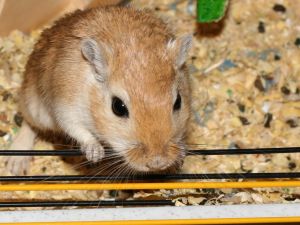Gerbilling: Difference between revisions
meta>Asher196 Undid revision 475767043 by 108.72.202.79 (talk) |
meta>Barek m Protected Gerbilling: Persistent vandalism ([edit=autoconfirmed] (expires 17:34, 18 February 2012 (UTC)) [move=autoconfirmed] (expires 17:34, 18 February 2012 (UTC))) |
(No difference)
| |
Revision as of 17:34, 8 February 2012

Gerbilling, also known as gerbil stuffing or gerbil shooting, is an urban legend that describes a supposed sexual practice of inserting small live animals (usually gerbils but also mice, hamsters, rats and various other rodents) into the human rectum to obtain stimulation.
Folklorist Jan Harold Brunvand records that the urban legend began in 1984, and initially involved a mouse and an unidentified gay man. In subsequent years this story metamorphosed into a gerbil, and was applied to several named male celebrities that were publicly supposed to be gay.[1] Rumors surrounding various male celebrities engaging in gerbilling have become popular urban legends over the years.[2]
There are no reports in peer-reviewed medical literature describing gerbilling.[3][4]
See also
References
- ↑ Brunvand, Jan Harold (2001). "The Colo-Rectal Mouse". Encyclopedia of Urban Legends. W.W. Norton & Company. p. 81. ISBN 978-1-57607-076-5.
{{cite encyclopedia}}: Unknown parameter|isbn13=ignored (help) - ↑ Brunvand, Jan Harold (2001). "Gerbiling". Encyclopedia of Urban Legends. W.W. Norton & Company. p. 166. ISBN 978-1-57607-076-5.
{{cite encyclopedia}}: Unknown parameter|isbn13=ignored (help) - ↑ Adams, Cecil (1986). "Is It True What they Say About Gerbils?" The Straight Dope, March 28, 1986.
- ↑ Template:Cite pmid
Further reading
- Norine Dresser (July 1994). "The Case of the Missing Gerbil". Western Folklore. 53 (3): 229–242. JSTOR 1499810.
- Barbara and David P. Mikkelson (2001-11-18). "From Gere to Eternity". Urban Legends Reference Pages.
- Cecil Adams (1986-03-28). "Is it true what they say about gerbils?". The Straight Dope.
- Becky Vorpagel (1988). "A rodent by Any Other Name: Implications of a Contemporary Legend". International Folklore Review. 6: 53–57.